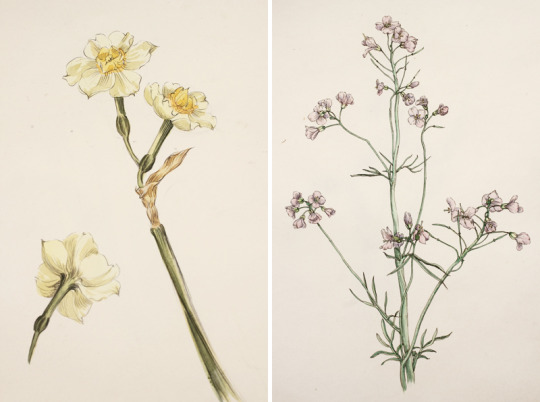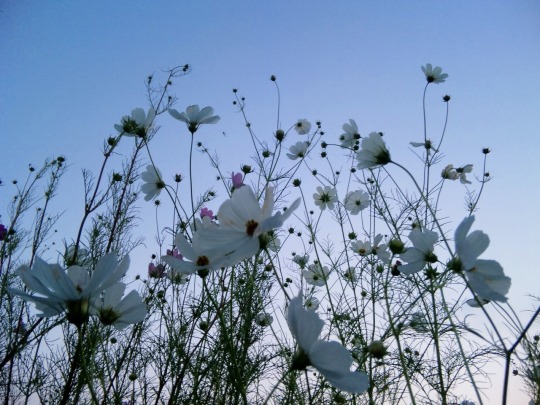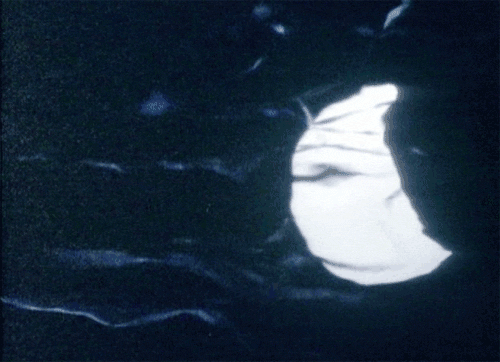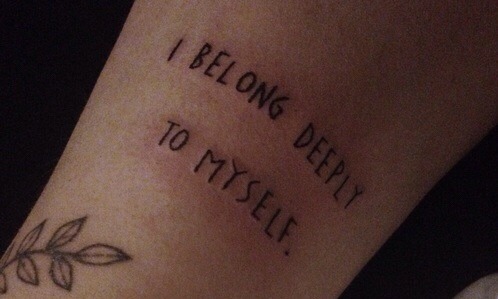-Aisling, 19 and from Dublin, Ireland. Analysing the poetry of Emily Dickinson (cus why not)
Don't wanna be here? Send us removal request.
Text
‘The Bible is an antique volume’ by Emily Dickinson- analysis
As noted in A Companion to Emily Dickinson, the provocative ‘The Bible is an antique volume’, appears to the eye as a single stanza poem, but ‘’to the ear, the poem is heard as four staves’’. These four invisible staves mark the progression of the poem from one which appears to merely mock, to a cautioning, condemning tone that almost feels like a warning, and thus allows the true intention of the poem to subtly unfold. At the beginning of the poem, Dickinson appears to mock biblical stories and thus the reverence they receive. She calls attention to the physical nature of the book that was created by man’s hand, a ‘’volume’’ that was ‘’written’’, and therefore undermines the divine nature which it is often ascribed. By doing so she creates a parallel between this ‘’volume’’ and all others which were created in the same physical process, perhaps making a connection between the fictitious nature of other words on other pages and the capability for the Bible to also be a work of fiction, or at least subject to fallibility. She further undercuts the supposed religiosity of the Bible by using a word that suggests little depth or substance, ‘’antique’’, rather than the more reverential and monumental ‘’ancient’’, and by claiming that it was written by ‘’faded men’’, perhaps suggesting that the viewpoints of these characters are outdated and of little relevance to the modern day. The Bible was written, she says, at the ‘’suggestion of Holy Spectres’’, again drawing attention to the process of its creation. By using the word ‘’suggestion’’ she hints that the ‘evidence’ in the bible is not substantial, that it came from sources lacking credibility. She initially appears to represent the Bible, and by extension the religions that are founded upon it, as outdated, out of fashion, and lacking in substance or even truth. Dickinson then goes on to list some of the principal characters in the religious text, as if listing the characters of a play or, as Mary Loeffelholz and Martha Nell Smith suggest, characters in a romance novel, again satirising biblical tales. I would also argue she attempts to convey the great drama present in biblical stories, and therefore their potential as creative inspiration for Dickinson. Her last character listed, "Sin", is particularly noteworthy. She says "Sin- a distinguished Precipice Others must resist". Critic Helen Vendler claims this is a reference to Lucifer, a warning from preachers that their congregation must resist the temptations that Lucifer did not. However I would argue that this line also drips with sarcasm, as she references the hypocrisy within religious institutions and religious communities. This line marks a slight shift in tone and intent as it touches the heart of the poem, highlighting religion’s capacity to cultivate unhealthy judgemental attitudes and create divides within society. This sentiment is continued in the succeeding lines. "Boys that 'believe' are very lonesome" says Dickinson, suggesting that few boys are interested in the words of the Bible or the preacher, while those who have no faith or spiritual guidance are "lost". The quotation marks around "believe" and "lost" serve a dual purpose, helping to create a mocking tone while also alluding to the possibility that these were words arrogantly said in her community by those looking to dictate the lifestyle of others. The final line of the poem "Orpheus's sermon captivated, it did not condemn" is itself a condemnation of the judgemental, prying attitude of religious preachers. It is noticeable that Dickinson calls attention to the patriarchal nature of religious institutions, as the words were created by "faded men" and preached to "boys", again emphasising religions tendency to create schisms in society. Her depiction of religion here is of an institution that seeks to control and regulate, seeped in hypocrisy. However, she also offers a solution. It is suggested that if the Bible was preached in a more enthralling and pleasing manner by a "warbling teller" as Orpheus was, it may perhaps captivate a wider audience: " all the boys would come". While she initially appears to impiously satirise the bible, she ultimately views the bible as a potentially positive influence, corrupted by the stigmas of preachers and the mindset they cultivate.
#emily dickinson#American poetry#Poetry Analysis#analysis#bible#thebibleisanantiquevolume#lit crit#literature
2 notes
·
View notes
Text
‘To make a prairie’- Emily Dickinson analysis
This term, from September to December, I took a module as part of my English degree which focused solely on works produced by American authors (which was fascinating and v fun, definitely my favorite module so far <3). One of the things that was often discussed was the ways in which the spirit upon which the US was founded has permeated down through the generations, influencing the modern American ethos and thus American literature. This lens was one of the most interesting through which to read ''To make a prairie''. The poem essentially captures the adventurous, optimistic and audacious spirit on which the United States was founded. Dickinson gives instructions for the construction of a prairie from scratch, and while the American landscape was lush, teaming with life and inhabited by Native Americans long before European colonialists arrived, the early settlers believed they were inheriting a blank expanse from God on which they were to construct their new home and a new country. The ''prairie'', a type of landscape only found in North America, can be read as a metaphor for the United States itself, a vast land of diversity and beauty boldly founded, with ''one clover and a bee. And revery''. The ''revery'', or visionary idea, of the settlers was to construct a new and exceptional country, a modern Eden and a 'city upon a hill' which would serve as a model of modern civilization for the rest of the world. This revery, the conception of the United States, was birthed by venturesome determination, even when faced with seemingly insurmountable odds. Dickinson expresses this in the line ''the revery alone will do, if bees few'', which calls to the settlers will and determination to carry out their mission despite a lack of resources. This shortage of resources is reflected in the fabric of the poem, as it is a short and simple poem containing a total of only four nouns, which are repeated multiple times. The simplicity of the colonialist’s dream is thus reflected in the simplicity of the language. However, this is not the only angle from which this poem can be viewed. Dickinson also sums up, with humble language, the necessary elements for the creation of art. To create something, symbolized here by the prairie, one can use inspiration from the world around them, such as ''a clover and one bee''. The choice of a clover and bee highlights Dickinson's fascination with the ordinary and the humble, as well as her use of the natural world as a well of poetic inspiration. However, one cannot create something new with what can be observed alone; one needs imagination, or ''revery'', and if one finds what they can observe lacking, ''if bees are few'', then they can delve entirely into the imagination and create from what is found there.
#emily dickinson#to make a prairie#prairie#poety#poetry analysis#american poetry#answer#literature#lit crit
0 notes
Photo

“No man understands a deep book until he has seen and lived at least part of its contents.” -Ezra Pound
2K notes
·
View notes
Quote
… and I am out with lanterns, looking for myself.
Emily Dickinson (via chocolatefrogs)
195 notes
·
View notes
Photo





Dickinson, Emily, 1830-1886. Herbarium, circa 1839-1846. 1 volume
Compiled by Dickinson when a student at Amherst Academy.
144 notes
·
View notes
Text
’Hope’ is the thing with feathers-
‘’’Hope’ is the thing with feathers’’ is one of Dickinson’s most well-known poems, and is often cited as a celebration of the power of hope, and its essential function in individual’s lives. The poem is short and its language is simple, with a rhyming scheme that conveys Dickinson’s confidence in her message. She begins the poem with a definition, and by not using the specific noun she employs later ‘’bird’’, but instead says ‘’the thing with feathers’’ Dickinson positions herself as an explorer, a discover and an analyst who will consider her subject carefully and dissect and describe it with exactness and care, which she proceeds to do. At first, Dickinson avoids the first person, and instead speaks generally. Her use of the definite article, i.e. ‘’the’’ instead of saying ‘’a’’ is noticeable and notable in this poem, as she uses it frequently: ‘’the thing’’, ‘’the soul’’, ‘’the tune’’,’’the words’’ and so on. This speaks to the universality of hope as a central and intrinsic aspect of being human, and a deep and inherent connection between all human beings, something with which we are all familiar. To me, the use of singular nouns creates the strange impression that we all are inhabited by the same soul, within which the same tune is played, and so hope is here positioned as something that binds each one of us to everyone else inextricably. It is thus a uniting force. It is during hardship that hope is most relieving ‘’and sweetest- in the Gale- is heard’’ and most powerful ‘’and sore must be the storm- that could abash the little Bird’’. In the final stanza, Dickinson speaks in the first person for the first time in the poem, recalling hope’s tune, i.e. its reviving power, in the most hostile and isolated of landscapes, ‘’in the chillest land- and on the strangest Sea’’, and in these harsh and frosty environments, a metaphor for times of hardship, it is hope that ‘’kept so many warm’’, including herself. The final two lines of the poem, ‘’Yet-never- in Extremity, it asked a crumb- of me’’ is personal and specific to Dickinson, as is the whole stanza, beginning with ‘I’ve’ and concluding with ‘’me’’. The last two lines are extremely emphatic, with the definite word ‘’never’’ encased and emphasized by two dashes, and the capitalized word ‘’Extremity’’. The emphatic and personal nature of these final lines appears to be a rare example of choked-up emotion in Dickinson’s work, as she appears to convey her own gratitude for hope’s selflessness and life support. While on the surface ‘’Hope is the thing with feathers’’ appear to celebrate the durability and permanence of hope as it ‘’never stops- at all-‘’ the pause created by the dash at the end of that line is a hint towards the flip side of this poem. The dash appears to ask the reader to reflect on what was just said, and thus lends a sense of unease, as the uncertain undercurrent of the poem is realized. Hope, as portrayed in the poem, is not an enmeshed in the fabric of the soul. It is not an intrinsic part of it, and Dickinson expresses this with an uneasy word: ‘’perches’’. ‘’Perches’’ is precarious and, despite the assurance of line four, implies transience, that hope may leave us. Then there is the description of the little bird forced to confront gales and storms, with the juxtaposition of the forceful and onomatopoeic ‘’abash’’ with the delicate description of the ‘’little’’ bird. While the poem can be read as a positive acknowledgement of one of humanity’s most unique traits and most valuable safety net, Dickinson’s awareness of precarious nature of hope and its ability to be damaged or to leave us cannot be overlooked.
#emily dickinson#hopeisthethingwithfeathers#hope#hopeful#hopelessness#poetry#poetry analysis#answer#english#literature#lit#american poetry
1 note
·
View note








